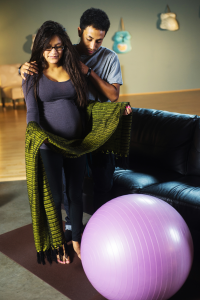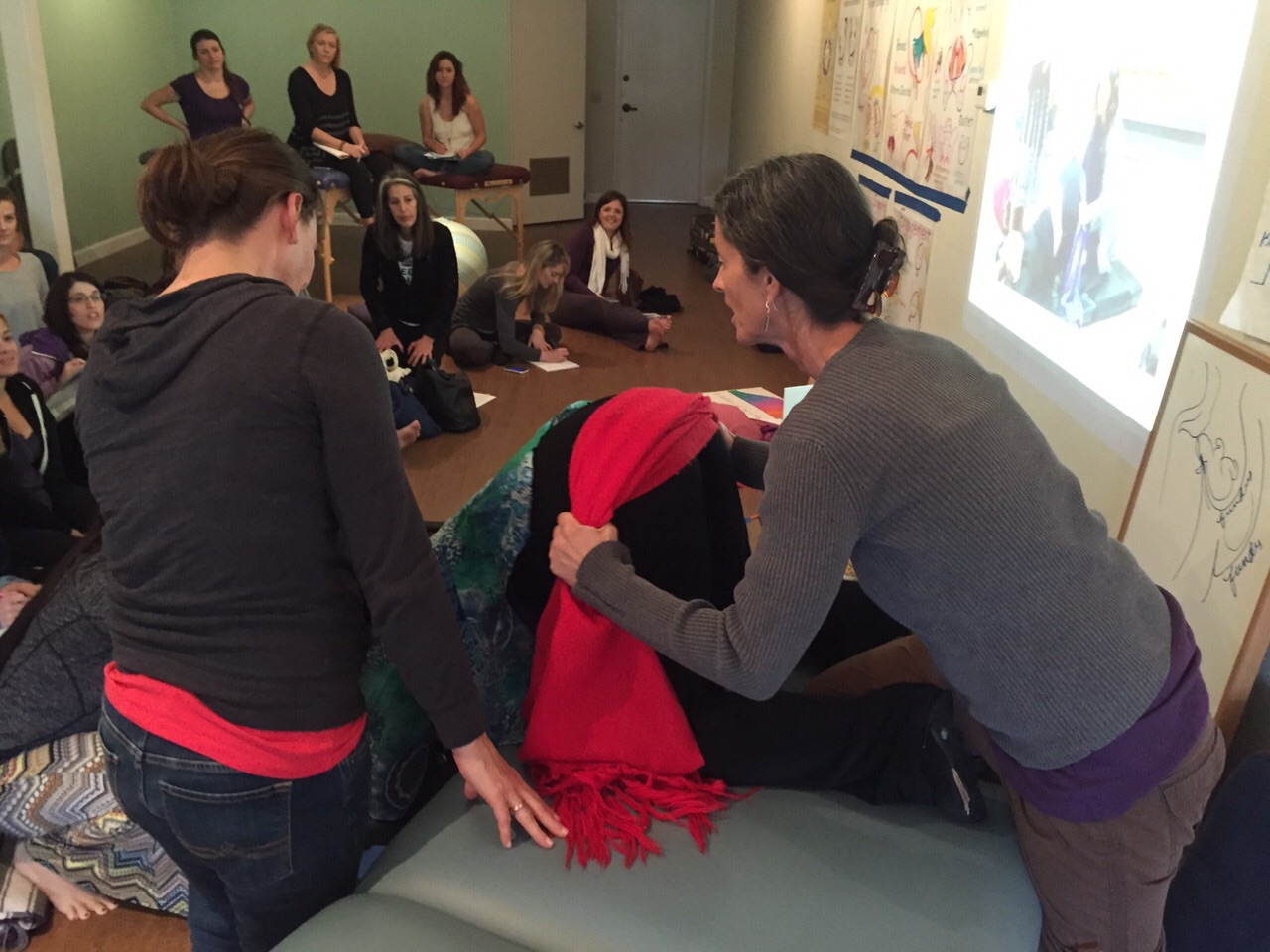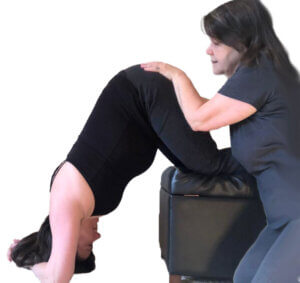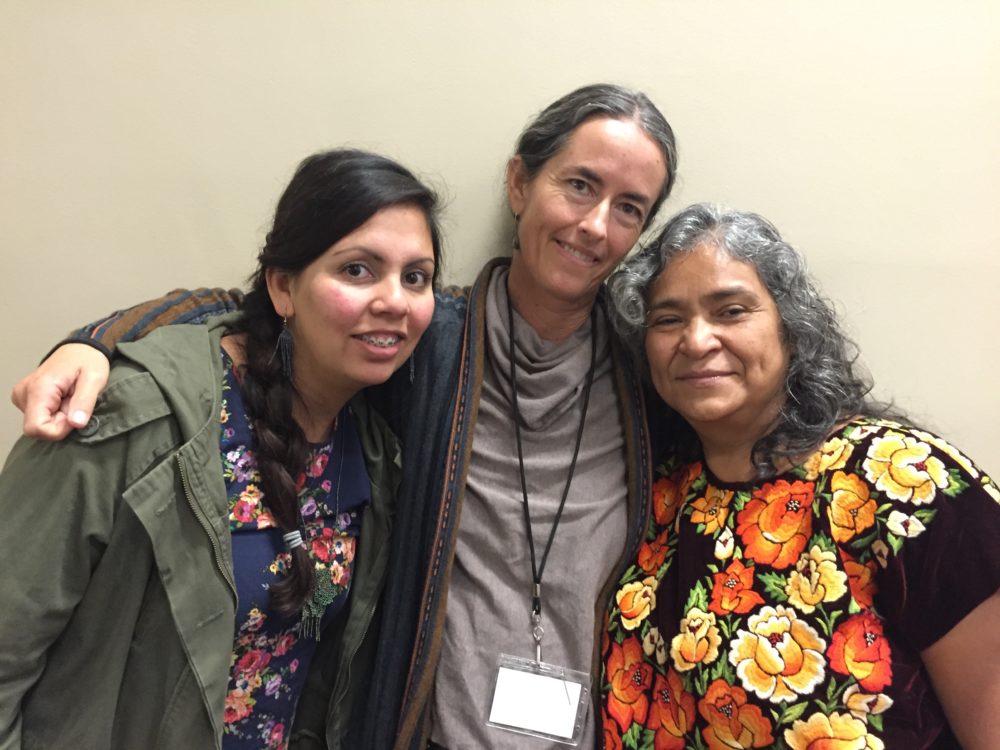
The Rebozo is a special woven cloth, woven by indigenous weavers generation after generation. The Rebozo is a cultural emblem as well as an artifact of women’s ceremony and daily life. The beautiful traditions of using an authentic Mexican Rebozo are handed down from mother to daughter and midwife to midwife.
From 2003 until 2020, Spinning Babies® three primary ways of body balancing we refer to as The Three Sisters of BalanceSM led with the Rebozo “sifting.” The way of sifting differs whether on the abdomen (super gentle) or the hips (gentle or moderate).
As of 2019, Spinning Babies® began to teach The Jiggle to meet the body’s needs for comfort through a sifting or vibration. Replacing the rebozo with a less culturally specific way to vibrate the body makes room for the Indigenous healers, midwives and teachers who have arrived with more skilled services and use of the rebozo than we intended with our 2-3 simple examples of rebozo use.
I am humbled to have introduced the Rebozo to this young couple of Maya ancestry during their first pregnancy while they lived in my northern city, far from their elders. I’ve been honored to introduce the Rebozo in labor to indigenous couples who had me as a doula or midwife. However, today I can use other methods to achieve similar parasympathetic responses and make room for the new Indigenous owned businesses offering rebozo expertise. I support the stronger identify of the rebozo that occurs as Indigenous presence rises. I choose to support the Indigenous use over my own because I believe it moves towards equity in culture and market.
Midwives whose families have used the Rebozo tradition are more accessible to their own communities and to the world today than when Spinning Babies® incorporated Rebozo use. To support these midwives and the strength of their lineage of knowledge we refer to them.
Spinning Babies® recognizes the indigenous wisdom and history of the Rebozo. The midwives whose lineage carries the Rebozo forward had (and have) their human right to care for birthing families suppressed by their government’s lack of support for their vital role.
We have a commitment to increase the respect for the Rebozo around the world and support the lineage of this treasured tradition.
Scroll down to see what Spinning Babies® is doing about cultural respect for the Rebozo in our community.
Manteada is the Spanish name of the Rebozo technique used by Mexican midwives. Manteada is a gentle sifting technique, like a rhythmic jiggle. It is done for pregnancy, birth, postpartum, and even fertility. (This description was shared with Spinning Babies® by Midwife Ximena Rojas García.)
Use of the Rebozo cloth is prioritized to practitioners of the Rebozo lineages (People with Indigenous connections to Mexico, Central and some parts of South America). Read more below about why and how we show our expanding awareness to show respect the Rebozo.
One of the many uses of the Rebozo is to sift or jiggle the pregnant abdomen or pelvis. Vibration is a technique to improve fascia function to help pregnancy comfort and birth ease.
Are you interested? Find an Indigenous practitioner with Rebozo Manteada traditions.
Gentle sifting with the Rebozo aims to:
Even though we no longer teach the couple of techniques we taught with the Rebozo (unless “we” means our community members for who this is of their lineage), we want to put this warning here because there are reports of people in the general birth field doing vigorous shaking (misuse) with a cloth. This was not our way of demonstrating and does not reflect what we have taught in the past.
Don’t do abdominal jiggling without preparation, fast, or to the point of shaking. Avoid at all when the person experiences pain or spasms in the front. Pain in the front may be from the round ligaments. For instance, if pain is felt when a doctor or midwife feels into the lower belly for the baby’s head, then sift very slowly. If the sharp muscle pains have been recent (within two weeks) in lower front abdomen at times, then a quick jiggle could bring on another spasm.
Don’t do this if there has been bleeding from the placenta or for unknown reasons from the vagina; or if the pregnant person doesn’t want to or if there is discomfort.
Don’t try to manipulate the baby’s position by a forceful flip at the end. Trust the release. When the baby finds room, the baby will move. Traditional use of the Rebozo involves more than shaking the belly with the cloth. Safety increases with the cultural context and the wholistic approach with massage and palpation used by Mexican Parteras who learn the skills from adolescence if not before.
Don’t jiggle or sift abruptly if there is an anterior placenta. We taught this technique with gentleness but some people do it with force. There has been suspicion of abrupted placenta in one case that is feasible and another rumor of an abrupted placenta. I believe there are thousands of pregnant people being relaxed with the rebozo. It is safe when used properly. Is it that the helper is too vigorous in these cases? Day trainings of the Rebozo got popular over the last twenty years.
Learning something in hours that a midwife of the tradition learns in a lifetime will obviously lack a lot of finesse. This is not the reason we have reduced showing Rebozo techniques in many of our workshops. Our Approved Trainers made an emphasis on being gentle and also list the contraindications to sifting (and list their teachers and origins with respect). How we teach it doesn’t mean all who use it can replicate the technique with the gentleness it requires.
There’s a baby in there!! And also a placenta!
In active labor, either with hands or the Rebozo can be used to release the pelvic diaphragm (pelvic floor and fascia) in something called Shake the Apples. Remember, don’t shake vigorously.


Please note: We use Forward-leaning Inversion with hip shaking (can you be gentle?) ONLY when the baby’s head is mis-engaged and can’t rotate or descend, as proven by the labor stall and an exam by the nurse, midwife, or doctor. Don’t do this in a normally progressing labor or if there are contraindications to inversion.
Bringing the baby back up out of the pelvis 1 cm is enough to allow the strong contractions to rotate the baby while contractions also keep the head down by the downward action of the contraction. This combo of techniques is best done with the supervision of an experienced birth care provider.
The midwives with life long and generational skills using the Rebozo will have their own list. Because we are in a transition where some of our members might still be using the abdominal sifting with the Rebozo, I keep this list active here:
See our Changing Birth on Earth book or ebook for an alternate way of releasing the broad ligament or abdominal tension in the chapter on Balance.
A letter from Jennifer Walker sharing this change with our Certified Parent Educators
As you may have noticed there has been an update to the Three Sisters of Balance℠ [see page for changes there also] page on the website. The First Sister of Balance is now known as The Jiggle. We continue to honor the Rebozo Manteada (abdominal sifting) and other uses of the Rebozo. Some of our SpBCPEs will continue to use and teach the Rebozo Manteada without a change [i. e. Educators with roots linking them to the Rebozo]. Others will explore the Jiggle and begin teaching parents this technique in place of the Rebozo. We respect the cultural considerations in your choice. Our future trainings will focus on The Jiggle rather than the Rebozo Manteada.
Why have we made this shift?
All around the world, variations can be found of a relaxing and restorative technique we call jiggling. We use a simple name but the correct way to jiggle has gentleness, consent and finesse.
Spinning Babies® is moving to support the contributions of Indigenous midwives and the Rebozo. Therefore it is in this sign of respect that we redefine our Three Sisters of Balance℠. The Jiggle will now be our 1st Sister of Balance with full recognition that the Rebozo Manteada continues a valued prominence among traditional ways found around the world. We adjust our lens globally and honor the regional discovery of jiggling using the Rebozo as one of the many ways Parteras use their Rebozo.
We support our Parent Educators who are born of the lineage of the Rebozo and so hope they continue to use the Rebozo with pride and preservation of the cloth.
We are in transition and therefore hold space for our community’s needs to become more versed (educated and able to speak about Spinning Babies® respect for the Rebozo as well as their individual responses and adjustments) in their use and teaching of the Rebozo.
We want to work together to become versed in the dialogue of respect in ways that overcome simplistic descriptions of diversity so we [who are white and otherwise privileged in the USA] stop appropriation and the cultural near-sightedness common in the dominant culture.
What does this mean for you?
We are not asking our community to eliminate the use of the Rebozo Manteada, rather we are increasing our nuances in our respect of the Rebozo. We are not creating rules but are rather creating opportunities, materials and trainings prioritizing The Jiggle.
Many of you (but not all) learned the Jiggle during the SpBCPE training and can decide to use the Jiggle rather than Manteada. Those who were taught and feel it is appropriate for you to teach Rebozo Manteada can continue to share it with proper acknowledgement of its nuances and lineage. We won’t expect you to teach both in Parent Classes as we want you to take the time to be gentle, slower paced, and very tuned in to the fascia while demonstrating the Jiggle.
We acknowledge the purpose of the first sister is to use a gentle jiggle for fascia receptors. This receptor can be jiggled a number of different ways, depending on your background, experience and needs of the pregnant person.
We are currently updating the [Parent Class and professional workshop] powerpoint and other handouts to reflect this shift…
Jennifer Walker, Director of the Certified Parent Educator Program, Spinning Babies® Approved Trainer
…
Wondering what to do now? Check out The Jiggle.

Gail Tully has decided not to use the Rebozo in her teaching as of late 2019.
But here is the background covering when Gail was Using the Rebozo in her doula training and Spinning Babies® Workshops.
Gail Tully was taught to use the Rebozo for comfort in pregnancy and birth by Mexican birth experts Elena Carillo, Guadalupe Trueba, and Angelina Martinez Miranda. A valuable discussion with midwife and Rebozo ceremony facilitator, Bianca Tema Quinonez, directed me to examine how Spinning Babies® uses the Rebozo on the website and in our workshop. I was able to follow up by discussing our use with midwife and Rebozo teacher, Naoli Vinaver.
The Mexican Midwives Association sent word through Ximena Rojas Garcia that they are in support of Spinning Babies®, and about 2018 sent word through Ximena to allow me to teach some simple uses as long as we promote respect for the origins, history, and greater understanding of this valuable tradition. I received the news with great honor and humble gratitude. We look forward to more opportunities of cooperation and to preserve Mexican midwifery culture and wisdom even though our organization doesn’t broadly teach the Rebozo. (Remember, we have some members who are of what I call the Rebozo lineage and continue their own work with the Rebozo and can teach the forms of fascia vibration to address the needs of the fascia with it.)
After speaking with cultural activists, Spinning Babies® has made a commitment to give back 1% of profits to Black and Indigenous activities that will support the Rebozo and ways to reduce birth disparities. We no longer sell Rebozos but link directly to a BIPOC business for sales. Profit is allotted to BIPOC midwifery students to help offset a bit of their graduation test costs.
We continue to offer a seat per workshop to a Black or Indigenous Birth Worker (or pregnancy body worker) at every North American professional workshop, and, in some regions of the world, give a seat to a person from a community where birth disparities other than race harm mothers and babies in workshops when race by itself isn’t an equity factor. For instance, a Romany birthworker would receive access in Europe as well. Access has been Gail’s commitment since 1999 when her doula workshops got underway.
Gail and her Approved Trainers uphold the value in sharing our respect for the Rebozo by directing attention to communities who use the Rebozo in daily life so they may uphold the wisdom of their traditions without elimination of culture.
It is very important to note that we are not teaching a Rebozo workshop. We still have a Daily Essentials video and the Parent Class video with Rebozo use on it. We are exploring the cost and production to replace the video. It is on our list to do.
All cultural appropriation is tragic. But not all uses of a traditional object are appropriation. Eliminating culture is a real risk that we at Spinning Babies® also seek to avoid. How these two tragedies are interpreted change with the times and abilities to address needs to obtain the greater good.
Ximena Rojas García from Vera Cruz, MX wrote just a few years ago:
Thank you Gail Tully for bringing the Rebozo all around the world with Spinning Babies®. We are all guardians of the ancestral medicines, we are remembering. The Rebozo is an extension of our bodies and the company to our hearts. The traditional Midwives from Mexico are happy to have their work all around the globe.
It’s important to note the time and location of the praise. Today Mexican American and Mexican midwives are teaching Rebozo workshops and related webinars on cultural appropriation of the Rebozo. Spinning Babies® is not a voice to teach Rebozo, but we remain supporters of the indigenous midwives right and work to preserve their birth and medicine traditions properly. Cultural roots are vital for human diversity and health.
We have now shifted to supporting our community leaders and members to thoughtfully consider their use of the Rebozo in their practice.
Do our Parent Educators and Approved Trainers have Indigenous heritage connecting them to the Rebozo? Several do. Gail and others do not.
As the Parteras come forth to teach globally, other cultural uses of a cloth for comfort in pregnancy and birth are rising to the attention of their cultural and regional descendants. We’ll be seeing more use of the cloth in birth by people of Russian, Celtic, African, Asian and other lineages.
Cohen, Susanna R., and Celeste R. Thomas. “Rebozo Technique for Fetal Malposition in Labor.” Journal of Midwifery & Women’s Health 60.4 (2015): 445-451.
Davis, V. (1988). The Mexican Jaspe (Ikat) Rebozo: Comments On Its History, Significance And Prevalence.
Iversen, Mette Langeland, et al. “Danish women’s experiences of the rebozo technique during labour: A qualitative explorative study.” Sexual & Reproductive Healthcare 11 (2017): 79-85.
Jordan, Brigitte. Birth in four cultures: A crosscultural investigation of childbirth in Yucatan, Holland, Sweden, and the United States. Waveland Press, 1992.
Paul, Julie A., et al. “Use of an early labor lounge to promote admission in active labor.” Journal of Midwifery & Women’s Health 62.2 (2017): 204-209.
Pitrou, Perig, et al. “Life, Awakened and Untangled: A Birth Ritual among the Mixe of Oaxaca, Mexico.” Current Anthropology 58.3 (2017): 000-000.
Rodríguez, D. E. (2017). El rebozo tradicional indígena. Un estudio etnográfico de la rebocería de telar de cintura de Guanajuato y Chiapas.
Trueba, G. (2001). Comfort Measures for Childbirth: The Rebozo Way (DVD). Available from: Guadelupe Trueba (email: gtrueba@ prodigy. net. mx).
For additional education to even further enhance your pregnancy and labor preparation, shop our extensive collection of digital downloads, videos, DVDs, workbooks, and more.